|
|
 |
Fiche d'espèce de Copépode |
|
|
Monstrilloida ( Ordre ) |
|
|
|
Monstrillidae ( Famille ) |
|
|
|
Monstrilla ( Genre ) |
|
|
| |
Monstrilla gracilicauda Giesbrecht, 1892 (F) | |
| | | | | | | Ref.: | | | Giesbrecht, 1892 (p.586, 589, 773, figs.F); Malaquin, 1901 (p.111); T. Scott, 1904 (p.245, figs.F); van Breemen, 1908 a (p.206, figs.F); A. Scott, 1909 (p.235, figs.F, Rem.); Sars, 1921 (p.16, figs.F); Rose, 1933 a (p.343, figs.F); Isaac, 1975 (p.3, 8, figs.F, Rem.); Grygier, 1995 a (p.65); Suarez-Morales & Escamilla, 2001 (p.1442 & suiv.: Rem.); Vives & Shmeleva, 2010 (p.176, figs.F, Rem.) |  Issued from : W. Giesbrecht in Systematik und Faunistik der Pelagischen Copepoden des Golfes von Neapel und der angrenzenden Meeres-Abschnitte. – Fauna Flora Golf. Neapel, 1892. Atlas von 54 Tafeln. [Taf.46, Fig.9]. Female: 9, habitus (lateral).
|
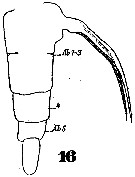 Issued from : W. Giesbrecht in Systematik und Faunistik der Pelagischen Copepoden des Golfes von Neapel und der angrenzenden Meeres-Abschnitte. – Fauna Flora Golf. Neapel, 1892. Atlas von 54 Tafeln. [Taf.46, Fig.16]. Female: 16, urosome (lateral).
|
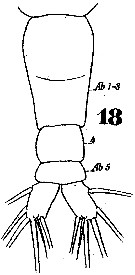 Issued from : W. Giesbrecht in Systematik und Faunistik der Pelagischen Copepoden des Golfes von Neapel und der angrenzenden Meeres-Abschnitte. – Fauna Flora Golf. Neapel, 1892. Atlas von 54 Tafeln. [Taf.46, Fig.18]. Female: 18, urosome (dorsal)
|
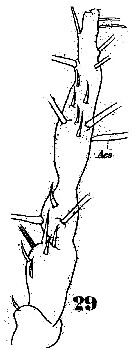 Issued from : W. Giesbrecht in Systematik und Faunistik der Pelagischen Copepoden des Golfes von Neapel und der angrenzenden Meeres-Abschnitte. - Fauna Flora Golf. Neapel, 1892. Atlas von 54 Tafeln. [Taf.46, Fig.29]. Female: 29, A1 (anterior view).
|
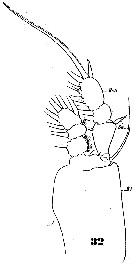 Issued from : W. Giesbrecht in Systematik und Faunistik der Pelagischen Copepoden des Golfes von Neapel und der angrenzenden Meeres-Abschnitte. - Fauna Flora Golf. Neapel, 1892. Atlas von 54 Tafeln. [Taf.46, Fig.32]. Female: 32, P3.
|
 Issued from : W. Giesbrecht in Systematik und Faunistik der Pelagischen Copepoden des Golfes von Neapel und der angrenzenden Meeres-Abschnitte. - Fauna Flora Golf. Neapel, 1892. Atlas von 54 Tafeln. [Taf.46, Fig.43]. Female: 43, P5.
|
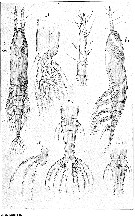 issued from : G.O. Sars in An Account of the Crustacea of Norway, with short descriptions and figures of all the species, 1921a, 8. [Pl. VIII]. Female (from Norway: Nordland coast): Urs, urosome (dorsal). Nota : Body with the anterior division slightly dilated in the middle. Cephalic segment about occupying half the length of the body. Tail exceeding half the length of the exposed part of the trunk. Eye easily observable in the living animal, though of a somewhat incomplete structure, lateral lenses small and rather remote from each other, being connected by a narrow stripe of dark pigment, ventral lens apparently imperfectly developed. A1 rather shorter , not even attaining half the length of the cephalic segment, and 4-segmented, the last segment about as long as the other 3 combined and somewhat fusiform in shape, with none of the setae ramified. Oral tubule occurring unusually far in front, at about the end of the first 1/3 of the cephalic segment Genital segment rather large, being considerably longer than the remaining part of the tail, and gradually narropwed behind, dorsal face with a very slight transverse suture in the middle ; ovigerous spines unusually short. Caudal rami comparatively small and somewhat divergent, each provided with 6 setae, one of which very short and attached somewhat dorsally. natatory legs without any denticle inside the 2nd basal segment, outer ramus considerably longer than the inner and having the terminal segment well developed, with the outer edge perfectly smooth. Last pair of legs somewhat clavate in outline, the inner edge forming a rounded expansion immediately inside the extremity, apical setae 3 in number and of nearly equal size. Body in the living animal rather transparent and in some places tinged with a light yellow pigment.
|
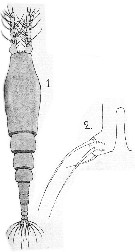 Issued from : A. Scott in The Copepoda of the Siboga Expedition Part I. Siboga-Expeditie XXIX a., 1909. [Pl. LVII, Figs.1-2]. Female (from 7°27'S, 117°49'E): 1, habitus (dorsal); 2, P5. A1 4-segmented, equal to half the length of the cephalic segment. Abdomen 3-segmented. Genital segment sub-cylindrical in shape and equal to twice the combined length of the next two segments. It is as long as the united length of the next two segments and caudal rami. The segment is marked by a faint suture traversing the middle. The 3rd abdominal segment of the siboga's specimen is very little shorter than the 2nd segment. Caudal rami about one a half times longer than the anal segment; each ramus with 1 outer marginal seta and 5 apical setae; the middle apical seta much shorter than the othjers. Apex of P5 rather inflated and directed at right angles to the body; apex with 2 long setae and 1 short. Nota: With the exception of the difference in the length of the 3rd of the abdomen the Siboga's specimen agrees well with the illustrations given by Giesbrecht.
|
 Issued from : T. Scott in Rep. Fishery Bd Scotl., 1904, 12 (3). [Pl. XIII, fig.8]. Female (from Scotland): 8, habitus (dorsal). Nota : A1 rather shorter, 4-segmented, the first three being small, while the end segment is equal to the entire length of the other three. P5 sub-quadrate in outline, rather longer than broad, and somewhat gibbous at the distal end ; each foot furnished with 3 plumose setae, one on the outer aspect and two at the apex, the feathering is very delicate Abdomen 4-segmented, the 1st segment which appears to consist of two coalescent segments, is of a sub-cylindrical form but tapers slightly towards the distal extremity ; it is about 1/3 longer than the breadth at the widest part and nearly 2 times the entire length of the next segments. The 3rd segment is only about half the length of the 2nd one. Caudal rami each provided with 6 setae , but one of the setae is very small.
|
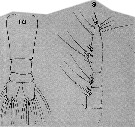 Issued from : T. Scott in Rep. Fishery Bd Scotl., 1904, 12 (3). [Pl. XIII, figs.9-10]. Female: 9, A1; 10, Abdomen and caudal rami.
|
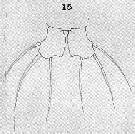 ssued from : T. Scott in Rep. Fishery Bd Scotl., 1904, 12 (3). [Pl. XIV, fig.15]. Female: 15, P5.
| | | | | NZ: | 5 | | |
|
Carte de distribution de Monstrilla gracilicauda par zones géographiques
|
| | | | | | | | | | Loc: | | | Arct., E Scotland, Firth of Forth, Firth of Clyde, Norway (Valdersund & Kvalø), English Channel, Medit. (Algiers, Napoli), Indian, Indonesia-Malaysia (Paternoster Islands) | | | | N: | 7 | | | | Lg.: | | | (5) F: 3,5; (46) F: 2,7; (663) F: 3,55; (727) F: 3,1; {F: 2,70-3,55} | | | | Rem.: | ? Perhaps Monstrilla anglica (F)
Voir aussi les remarques en anglais | | | Dernière mise à jour : 12/03/2020 | |
|
|
 Toute utilisation de ce site pour une publication sera mentionnée avec la référence suivante : Toute utilisation de ce site pour une publication sera mentionnée avec la référence suivante :
Razouls C., Desreumaux N., Kouwenberg J. et de Bovée F., 2005-2025. - Biodiversité des Copépodes planctoniques marins (morphologie, répartition géographique et données biologiques). Sorbonne Université, CNRS. Disponible sur http://copepodes.obs-banyuls.fr [Accédé le 03 juillet 2025] © copyright 2005-2025 Sorbonne Université, CNRS
|
|
 |
 |














